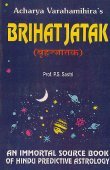Brihatsamhita, Bṛhatsaṃhitā, Brihat-samhita: 7 definitions
Introduction:
Brihatsamhita means something in Hinduism, Sanskrit. If you want to know the exact meaning, history, etymology or English translation of this term then check out the descriptions on this page. Add your comment or reference to a book if you want to contribute to this summary article.
The Sanskrit term Bṛhatsaṃhitā can be transliterated into English as Brhatsamhita or Brihatsamhita, using the IAST transliteration scheme (?).
In Hinduism
Chandas (prosody, study of Sanskrit metres)
Source: Shodhganga: a concise history of Sanskrit Chanda literatureBṛhatsaṃhitā (बृहत्संहिता) by Varāhamihira (C. 550 C.E.) incorporates many subjects of many disciplines and presents them in a unique way. The purpose of Varāhamihira is to illustrate all branches of learning and thus names his work as Bṛhatsaṃhitā: a big collection. Out of chapters, the 104th Chapter deals with the metres of Sanskrit.

Chandas (छन्दस्) refers to Sanskrit prosody and represents one of the six Vedangas (auxiliary disciplines belonging to the study of the Vedas). The science of prosody (chandas-shastra) focusses on the study of the poetic meters such as the commonly known twenty-six metres mentioned by Pingalas.
Languages of India and abroad
Sanskrit dictionary
Source: DDSA: The practical Sanskrit-English dictionaryBṛhatsaṃhitā (बृहत्संहिता).—Name of a work on astrology by Varāhamihira.
Bṛhatsaṃhitā is a Sanskrit compound consisting of the terms bṛhat and saṃhitā (संहिता).
Source: Cologne Digital Sanskrit Dictionaries: Cappeller Sanskrit-English DictionaryBṛhatsaṃhitā (बृहत्संहिता).—[feminine] T. of a work.
Source: Cologne Digital Sanskrit Dictionaries: Aufrecht Catalogus Catalogorum1) Bṛhatsaṃhitā (बृहत्संहिता) as mentioned in Aufrecht’s Catalogus Catalogorum:—[dharma] by Vyāsa. B. 3, 112.
2) Bṛhatsaṃhitā (बृहत्संहिता):—jy. by Varāhamihira. [Mackenzie Collection] 120. Io. 590. W. p. 238. Cambr. 61 ([fragmentary]). Paris. (B 188). L. 1491. K. 242. Kh. Vi. 74. B. 4, 194. Report. Xxxv. Ben. 30. Bik. 346. Kāṭm. 10 (and—[commentary]). Pheh. 9. Rādh. 36. Oudh. X, 10. Xiii, 60. Xiv, 56. Xix, 66. Np. V, 2 (and—[commentary]). Viii, 54. 56. Burnell. 77^b. Oppert. 7343. Ii, 6416.
—[commentary] Rādh. 43.
—[commentary] Parimalasamā. B. 4, 194.
—[commentary] by Kumāratanaya Yogin. [Mackenzie Collection] 121.
—[commentary] by Bhaṭṭotpala. Io. 1798. W. p. 252. Oxf. 328^a. Cambr. 61 ([fragmentary]). L. 590. 1491. Ben. 30. Pheh. 9. Rādh. 36. NW. 526. Oudh. Iii, 14. Xiv, 56. Np. I, 142. Ii, 112. V, 92. Viii, 54. 56. Burnell. 77^b. Bhk. 35. Poona. 305.
—[commentary] by Mathurānātha Śukla. NW. 552.
—[commentary] by Viśvanātha. Oudh. Vii, 4. Bṛhatsaṃhitāyām Puruṣalakṣaṇa and Strīlakṣaṇa. Io. 2219.
3) Bṛhatsaṃhitā (बृहत्संहिता):—by Varāhamihira. Devīpr. 79, 14. Io. 590. 812. 1940. 2219. 2294. Oudh. Xx, 134. 136.
—[commentary] by Bhaṭṭotpala. Devīpr. 79, 14. Io. 891-93. 1798. 1871. 2171. Oudh. Xx, 136. Rgb. 834. Stein 167.
4) Bṛhatsaṃhitā (बृहत्संहिता):—by Varāhamihira. Ulwar 1960.
—[commentary] by Bhaṭṭotpala. ibid.
5) Bṛhatsaṃhitā (बृहत्संहिता):—by Varāhamihira. As p. 118 (2 Mss.). Bc 184. Bd. 852. L.. 988 ([fragmentary]). Peters. 5, 519 (inc.). Whish 72 (3, 1-26, 8). C. by Bhaṭṭotpala. As p. 118. Bd. 852. Whish 72 (3, 1-26, 8).
Source: Cologne Digital Sanskrit Dictionaries: Monier-Williams Sanskrit-English Dictionary1) Bṛhatsaṃhitā (बृहत्संहिता):—[=bṛhat-saṃhitā] [from bṛhat > bṛṃh] f. ‘the great composition’, Name of an astrological [work] by Varāha-mihira
2) [v.s. ...] of a philos. [work]
3) [v.s. ...] of a Dharma.
[Sanskrit to German]
Sanskrit, also spelled संस्कृतम् (saṃskṛtam), is an ancient language of India commonly seen as the grandmother of the Indo-European language family (even English!). Closely allied with Prakrit and Pali, Sanskrit is more exhaustive in both grammar and terms and has the most extensive collection of literature in the world, greatly surpassing its sister-languages Greek and Latin.
See also (Relevant definitions)
Partial matches: Brihat, Samhita.
Query error!
Full-text (+5657): Varahamihira, Mayuracitraka, Kacchara, Arkagraha, Antaracakra, Manonmukta, Khanjanaka, Tanumurti, Arunakirana, Talikata, Agnivartta, Jringa, Tumbavana, Dushprekshita, Kunjaradari, Kurmavibhaga, Gandhambhas, Avantaka, Kshemadhurta, Gaganatala.
Relevant text
Search found 76 books and stories containing Brihatsamhita, Bṛhat-saṃhitā, Brhat-samhita, Bṛhatsaṃhitā, Brhatsamhita, Brihat-samhita; (plurals include: Brihatsamhitas, saṃhitās, samhitas, Bṛhatsaṃhitās, Brhatsamhitas). You can also click to the full overview containing English textual excerpts. Below are direct links for the most relevant articles:
Hindu Architecture in India and Abroad (by Prasanna Kumar Acharya)
Minerals and Metals in Sanskrit literature (by Sulekha Biswas)
8. Non-gem materials in the Varahamihira’s Brihatsamhita < [Chapter 8 - Non-gem Minerals and Metals in Rasa-shastra]
7. Concluding Remarks and References < [Chapter 7 - A millennium of Ratnashastra (gemmology) literature in India]
1. Introduction to Ratna-shastra (gemmology) literature < [Chapter 7 - A millennium of Ratnashastra (gemmology) literature in India]
Vrikshayurveda (and environmental philosophy) (by Beenapani Mishra)
2. Religious Importance of Auspicious and Inauspicious Plants < [Chapter 5 - Religious Significance of Plantation and Rearing of Trees]
3. Aesthetical Values as reflected in other Sanskrit Texts < [Chapter 6 - Aesthetic Value behind the arrangement of Trees and Gardens]
2. Aesthetical Values as reflected in Vrikshayurveda < [Chapter 6 - Aesthetic Value behind the arrangement of Trees and Gardens]
Prayogamanjari and Saivagamanibandhana (Study) (by R. Suthashi)
Worshipping of trees for making Linga < [Chapter 3 - Shaiva iconography in Saivagamanibandhana]
Iconography in Kerala Tantric Literature: a general survey < [Chapter 1 - Introduction]
Vastu-shastra (Introduction to Indian architecture) (by D. N. Shukla)
(iii) The Schools of Architecture and the Allocation of the Samarāṅguṇa < [Chapter 5 - Study of Hindu Science of Architecture]
Chapter 4 - Prāsāda styles (A): Nāgara < [Volume 5 - Temple Architecture]
Chapter 7 - The Principal Components < [Volume 3 - House Architecture]
Devi Tantra, Mantra, Yantra (study) (by Srider Basudevan Iyer)
Worship involving Women < [Chapter 4 - Worship and The Worshipper]
Later Vedic goddesses (5.1): Lakshmi < [Chapter 2 - The Maior Goddesses]
Later Vedic goddesses (3): Parvati and Uma < [Chapter 2 - The Maior Goddesses]
Related products

